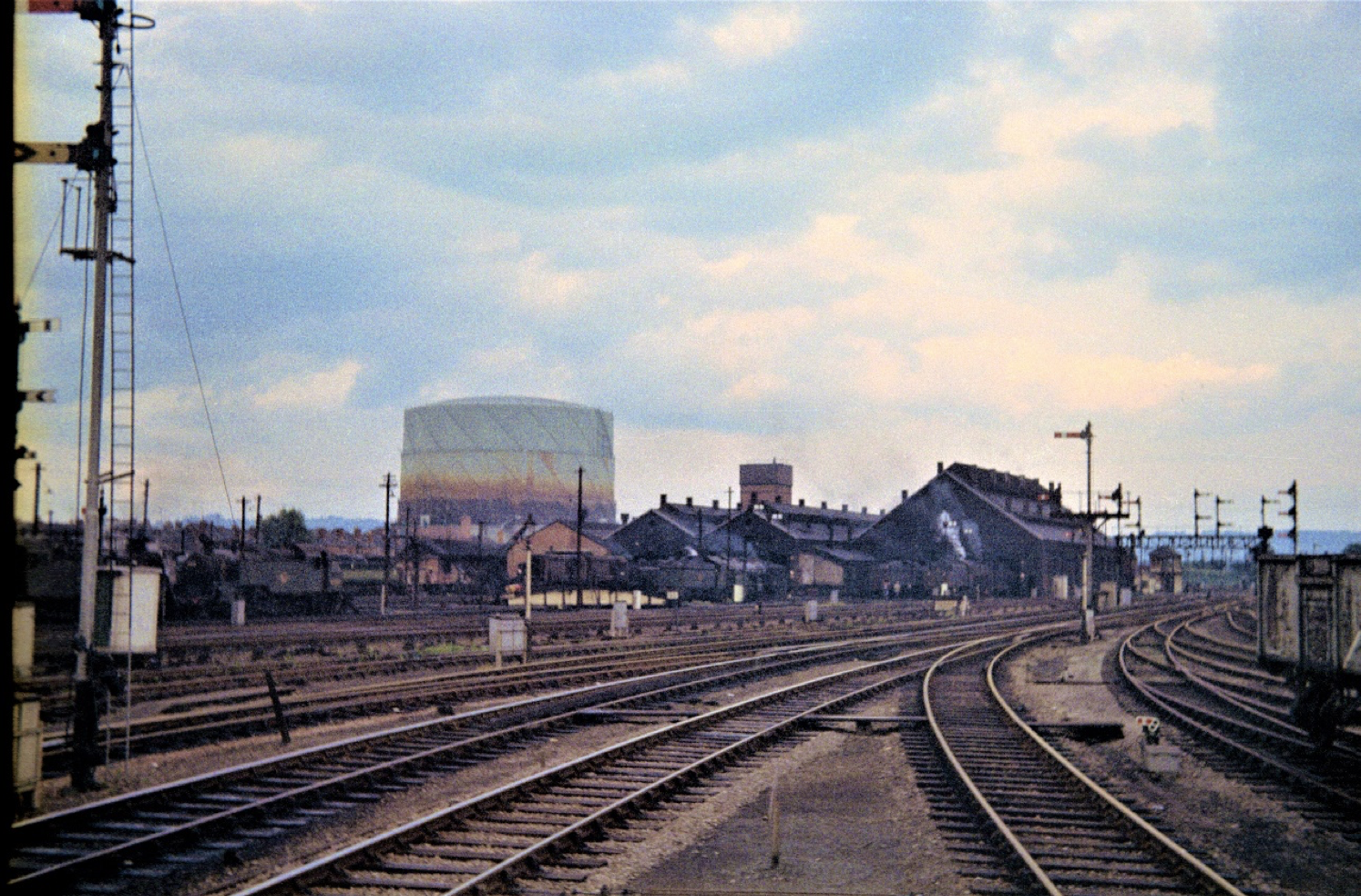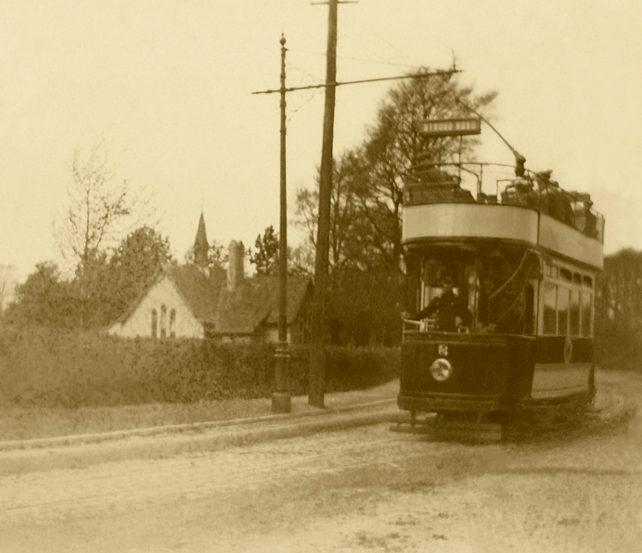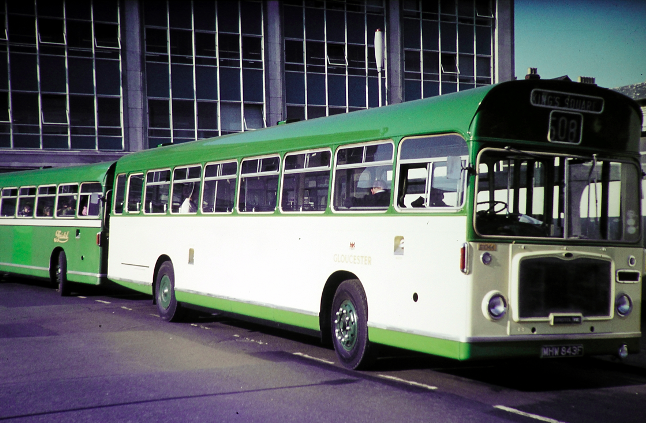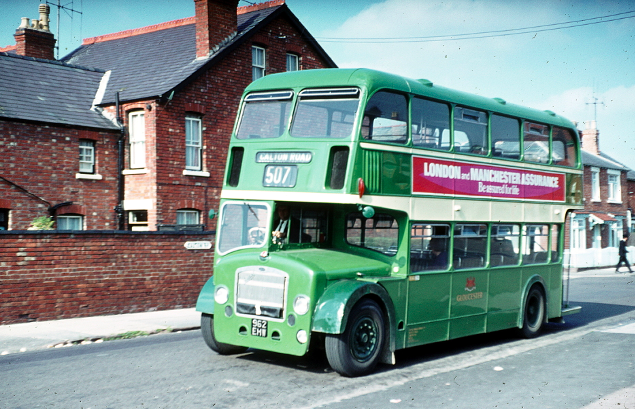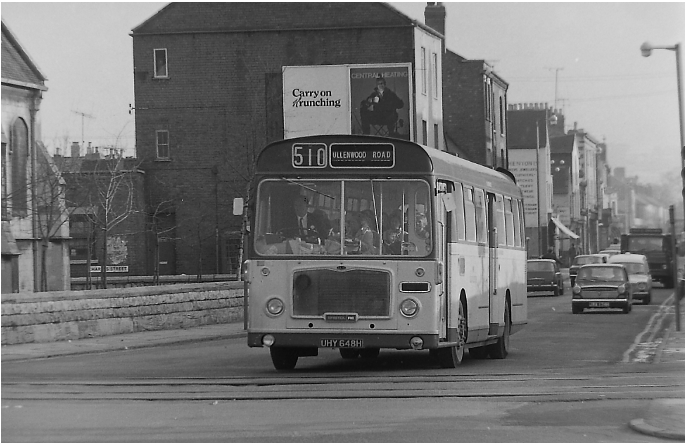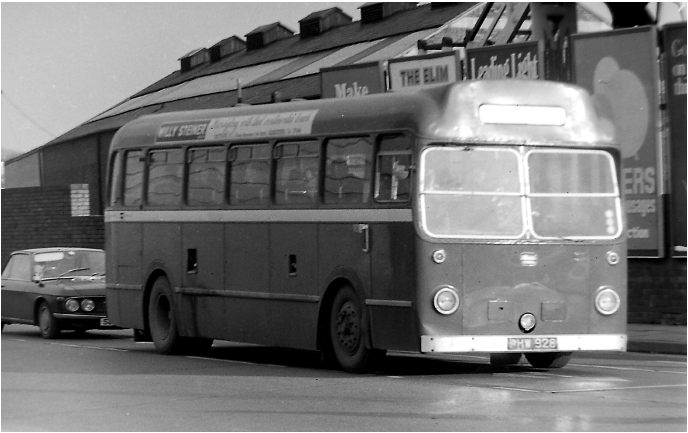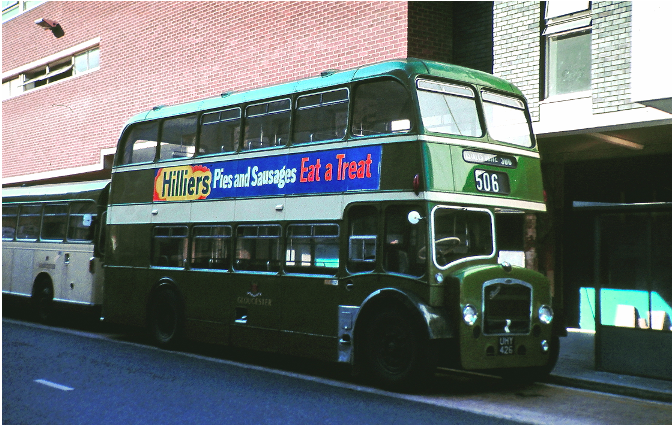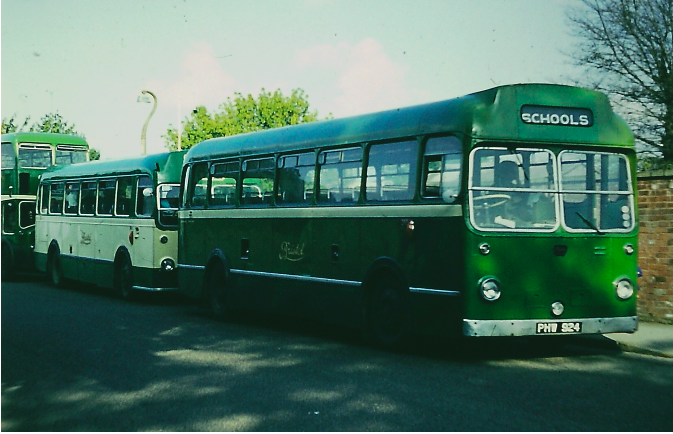BUS SERVICES IN GLOUCESTER
Gloucester City Services
The predecessor of the existing public transport service in Gloucester was the Gloucester Light Railway, an electric tramway system that replaced horse-drawn trams that had been introduced in 1880s. Electric trams were inaugurated in May 1904, with routes extending outwards from the Cross to Westgate Bridge, Wotton via London Road, India Road via Barton Street, Stroud Road at Tuffley, and Tuffley Avenue via Bristol Road. The tram depot was initially at India Road, but moved later to Lysons Avenue, off the Bristol Road.
Gloucester tram no. 8 at the Stroud Road terminus shortly after inauguration of the electric tramway. The tram is at what is now St Barnabas church, with the still existing Tuffley schoolhouse in the right background. Behind the tram is the abutment of the ‘Black Bridge’ carrying Stroud Road over the railway at Tuffley Junction [photo: H C Baldwin collection].
However, Gloucester Corporation commenced bus operations in September 1929, with buses progressively replacing trams until the tramway system was abandoned in 1933. The bus fleet was composed mainly of Thorneycrofts with locally-made GRC&WCo. bodies. The Corporation continued to run buses until 1936, when a joint agreement was entered into with Bristol Tramways and Carriage Co Ltd to take over the running of City services, the Corporation continuing to have a financial interest in the operations. The buses adopted a blue livery incorporating the City’s coat of arms. In 1957, the company name was changed to the Bristol Omnibus Company, acknowledging that trams in Bristol had been withdrawn much earlier in 1941, hastened by the bombing of Bristol city centre during WWII.
In 1937, the single-decker Gloucester fleet was amalgamated into the main Bristol Tramways fleet, when the final fleet numbering system came into use. City buses were numbered in a separate series from the main fleet: single-deckers in the 1200 series; double-deckers in the 1500 series, and 8-foot wide double-decks in the 1800 series. The separate numbering system for City buses was replaced in February 1959 by a series that adopted the simple procedure of applying a G-prefix to new City fleet buses which were allocated numbers in the main Company series. However the separate number series for City buses was discontinued by May 1966. Appendix I summarises the vehicle fleet from 1937 until the advent of the Cheltenham and Gloucester Omnibus Company in 1983.
My earliest memories were of the green buses used on Gloucester City services, which could be identified by the City’s coat of arms and motto (‘Fides Invicta Triumphat’) displayed on the side panels. This distinguished them from the Country buses carrying Bristol’s coat of arms (‘Virtute et Industria’), being the motif for the Bristol Tramways & Carriage Company. Both sets of vehicles used the same garage in London Road, Gloucester, but buses were normally kept strictly to their respective spheres of operation.
Later in 1967, GLOUCESTER was added beneath the City coat of arms as a fleet-name. One of the prototype VR demonstrators, HHW933D was photographed in this livery, although from memory it never operated in Gloucester.
For many years from the fifties, the City fleet comprised around 35 to 40 vehicles. These were replaced at a rate of three or four vehicles a year, enabling the fleet to be totally renewed in about 12 years. This policy continued until the last new double-deckers, Bristol FLF6Bs, were delivered in 1966. For the next ten years, single deckers, initially RELL6Ls and then Leyland Nationals were preferred until the first front-entrance double-deckers (Bristol VRTSL3s) came into service in 1977.
I can remember being aboard a Bristol L-type single-decker on route no. 9 from the Infirmary in Southgate Street to Slimbridge Road: we were living in the Tuffley prefabs at that time. We were sitting at the back of the bus when the conductor caught my sister’s fingers in the rear door whilst closing it. Buses of this type included CFH604/5, and DFH449 and were still in use until 1962.
The double-deck batch with which I was most familiar when I lived in the White City were Bristol Ks KHU614-6, which used to work our local route no. 3 to Selwyn Road. This route always seemed to attract the oldest buses. The route was extended to St Barnabas Church when it was no longer considered safe for buses to do a reverse turn from Finlay Road at the Selwyn Road junction (Finlay Road was part of the A38 Ring Road, and the main route between the Midlands and the South West until the completion of the M5 in 1970).
However, I do remember seeing older double-deckers in the BFJ, HHT and JHT batches. Some of these survived longer by virtue of being re-bodied by Eastern Coach Works. The Bristol K was introduced in 1950, followed by the KS (60-seat version) and KSW (8 ft wide) variants. The prototype Bristol Lodekka (LD) dated from 1954 (the Dennis equivalent, the Loline dates from 1956), whilst the FS (flat-floored short version) dated from 1959, leading to production of the FLF (long, front-entrance). A new grille design for the Lodekka was introduced in 1962.
Other main routes were route nos. 1, 1A or 1B (Tuffley to Innsworth, Springwell Gardens or Pirton Lane) which normally had the newest buses. The first of the LDs fitted with the CBC-heating system (G8507-9) worked this service on their introduction in 1959. Service no. 6 from Matson to Oxstalls Drive was normally LDs, whilst route no. 10 to Coney Hill Parade also, like route no. 3, tended to have older buses. Most City routes departed from King’s Square; and prior to the opening of the existing bus station in Market Parade on 29 April 1962, Country services left from a bus station on the north-east side of King’s Square.
Two other cross-City services, route no. 7 (Calton Road to Longford) and route no. 9 (Slimbridge Road to Hucclecote) ran via Southgate Street and Northgate Street, and so did not call in King’s Square. By the time I went to the Crypt School, KSs were the mainstay of route no. 9 and route no. 7 was worked by Ks.
During the 1950s most city services were quite frequent, but most routes didn’t start until about 6.30am whilst they finished at 10.45pm, when a mass exodus would occur from King’s Square. On Sundays, services did not start running until 2pm, and finished by 10.30pm.
FLFs were the standard double-decker from 1963 to 1966, but in 1967 the policy changed and the high capacity RE was introduced although the capacity of the new fleet was limited, as the urban examples had separate doorways for entrance and exit and were thus restricted to 44 seats. Again, these were introduced on the two main trunk routes first, nos. 1 and 9.
A 1968 scene in King’s Square prior to its redevelopment. Bristol RE G1044 MHW843F in the reversed livery used for omo buses prepares to leave on route no. 508 to York Road, whilst to the rear an RE from the Country fleet in standard livery waits on route no. 510 to Coney Hill.
Bristol Omnibus introduced a new route numbering system in the nineteen-sixties; the 500 series being used for routes in the Gloucester area. City Services are listed below:
|
Route |
From |
To |
Via |
Frequency (mins) |
|
500 |
Tuffley |
Innsworth |
|
30 |
|
501 |
Tuffley |
Springwell Gardens |
|
60 |
|
502 |
Tuffley |
Pirton Lane |
|
60 |
|
503 |
Centre |
St Barnabas Church |
|
12 |
|
504 |
Grange Estate |
Hucclecote |
Grange Rd |
30 |
|
505 |
Grange Estate |
Hucclecote |
Holmleigh Rd |
30 |
|
506 |
Oxstalls Estate |
Matson |
|
15 |
|
507 |
Calton Rd |
Longford |
|
15 |
|
508 |
King’s Square |
York Rd |
|
30 |
|
510 |
King’s Square |
Ullenwood Rd |
|
10 |
|
511 |
Bus Station |
Sandhurst |
|
3 per day |
|
512 |
Bus Station |
Hempsted |
|
7 per day |
At this time major redevelopment of Eastgate area commenced, the old Market closing on 26 October 1968. With alterations to the road network, City buses that had used King’s Square were removed to Clarence Street, which they still use. The new pedestrianized King’s Square was unveiled in 1972. At that time changes were made to some routes. From 18 June 1972, the no. 506 Matson and no. 507 Calton Road services were truncated in the Centre; the Oxstalls Drive and Longford sections of the route being combined to create circular routes nos. 513/4 via Longford Lane and Cheltenham Road, Longlevens. Later, from 4 November 1973, route nos. 500-2 were split; with the Tuffley end of the route being renumbered no. 509, becoming OMO-operated by Bristol REs.
|
Route |
From |
To |
Via |
Frequency (mins) |
|
500 |
Centre |
Innsworth |
|
30 |
|
501 |
Centre |
Springwell Gardens |
|
60 |
|
502 |
Centre |
Pirton Lane |
|
60 |
|
503 |
Centre |
St Barnabas Church |
|
12 |
|
504 |
Grange Estate |
Hucclecote |
Grange Rd |
20 |
|
505 |
Grange Estate |
Hucclecote |
Holmleigh Rd |
20 |
|
506 |
Centre |
Matson |
|
12 |
|
507 |
Centre |
Calton Rd |
|
20 |
|
508 |
Centre |
York Rd |
|
30 |
|
509 |
Centre |
Tuffley Court |
|
12 |
|
510 |
Centre |
Coney Hill |
|
12 |
|
511 |
Bus Station |
Sandhurst |
|
3 MWFSO |
|
512 |
Bus Station |
Hempsted |
|
6 per day |
|
513 |
Longford |
Circular |
Longlevens |
20 |
|
514 |
Longford |
Circular |
Kingsholm |
20 |
Bristol FS GL8508 961EHW approaches the Calton Road terminus on route no. 507 in 1968.
On 31 October 1976 route nos. 500-2 were replaced by nos. 520-1, although they were renumbered again back to nos. 500-1 on 16 April 1978 still serving Churchdown, following a rationalisation of City and County routes which also involved nos. 547-8.
Several experimental routes were introduced during this time. Following the pedestrianisation of King’s Square a city centre mini-bus service at 15-minute frequency was introduced on 4 November 1973 using a Leyland/Asco Clubman minibus PHY647M, but this was withdrawn on 5 January 1974, and a new circular service no. 516 introduced at a 20-minute frequency. This service was not viable either and was withdrawn on 28 February 1976. A Saturday only route 515 at an hourly frequency was introduced between the Bus Station and the Cattle Market in 1973, but again was not well used, being withdrawn on 31 October 1976. Another experimental service, route no. 517 was introduced on 7 June 1976 to serve the Hospital in Great Western Road service at a 60-minute frequency, but never achieved the required patronage and so was withdrawn on 18 June 1977.
More successful was route no. 518 serving the new estate at Abbeydale which was introduced on 31 October 1976 running via Barton Street to a new terminus on Heron Way, initially at a 60-minute frequency.
Later in 1978, from 2 July the Lower Tuffley – Hucclecote routes were revised becoming nos. 520-3, with the introduction of a further routing option through Podsmead and the Royal Hospital. In addition, the country service to Brockworth and Witcombe was also renumbered from no. 554 to no. 524.
On 1 January 1969 the National Bus Company was created, and the Bristol Omnibus Company as one of the BTC group companies became part of the NBC, along with other companies in the BET group. With the advent of the NBC a new livery was introduced, and at least one LD, G8459 was repainted into the new livery complete with Gloucester coat of arms.
Two scenes at Barton Gates from 1970: RE G1153 UHY648H crosses the railway on an inward journey on route 10 from Coney Hill, whilst LS G2838 PHW928 waits on the Station Road approach to the traffic signals with a peak-hour extra.
Bristol LD G8297 UHY426 waits in Clarence Street on route no. 506 from Matson to Oxstalls Drive after the redevelopment of Kings Square, but prior to the splitting of the route in June 1972. The RE to the rear is probably working route no. 503.
Bristol LS 2834 PHW924 at the head of a fleet of school buses waiting outside St Peter’s Junior School Horton Road in 1970. Following are an unidentified MW, and FLF 7033 201NAE.
References:
https://rbwaters.wixsite.com/gloucestertransporthistory/
www.petergould.co.uk/local_transport_history
Bristol Omnibus Company Limited, 1937 – 1960, PH5, PSV Circle/Omnibus Society, May 1968.
